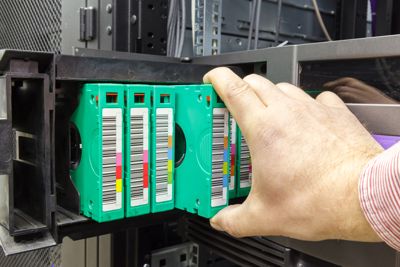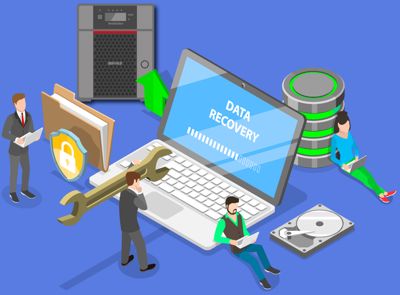Why Choose NAS Over Tape for Your Data?
By Tim Li, technical writer at Buffalo America
This is a Press Release edited by StorageNewsletter.com on June 29, 2022 at 2:02 pm This article was written by Tim Li, technical writer at Buffalo America since November 2012.
This article was written by Tim Li, technical writer at Buffalo America since November 2012.
Even if this comparison is made by a vendor of NAS, it’s interesting to read it as the analysis is excellent on tape and can be apply to any NAS. Editor.
Data security has been more important. Buoyed by the vulnerabilities brought on by the rise of remote work, such as sloppy cybersecurity practices amongst home workers, ransomware continue to threaten businesses of all sizes. Strained IT teams are searching harder than ever to seek out storage and backup solutions with higher security.

Since the best ransomware defense involves multiple backup options for redundancy, this has led to a resurgence in tape storage technology. For decades, many businesses have used LTO technology to store and backup their data. But as any storage medium, magnetic tape drives have their own advantages and disadvantages when it comes to storage and backup.
What Are the Benefits of Tape Backup?
Tape storage technology has long offered low cost and high security. Magnetic tape offers high capacity, with some even higher than traditional HDD storage, making them cost-effective as a storage media for large amounts of data.
Like other physical storage media, LTO offers more security than cloud storage alone. Since an LTO system does not offer Internet connectivity, tape storage is naturally air-gapped, rendering it immune from online-based cyberthreats that seek to access, encrypt, or otherwise compromise your data. As a storage media, data written to tape cartridges also cannot be altered or changed, adding an additional security layer.

Disadvantages of Tape Storage
Despite its benefits, LTO solutions have their disadvantages, particularly depending on the industry and the size of the business.
First and foremost is the cost. While tape drives cost less than disk storage per gigabyte, installing a new tape system takes a tremendous investment. While tape media can last longer than HDDs, they also requite specialized storage environments, as factors such as humidity and temperature will need to be carefully maintained. You will need to regularly purchase storage media and pay significant upkeep costs.
Due to the nature of LTO technology, data transfer rates may also impact your business. Tape storage does not allow for straightforward data reading and writing. Data usually has to be written to the tape right from the last write sector to prevent existing data from being erased. This rigid structure often leads to inadvertent data duplication, diminishing the high capacity. Tape storage also does not allow for true random data access, which is critical when it comes to DR. Restoring data from tape backup is a slow and tedious process, which is counterintuitive when it comes to data restoration for the purpose of avoiding downtime. For these reasons, magnetic tapes are considered best suited for archival data.
Lastly, tape storage does not scale well with business growth, as tape drives do not offer flexibility to integrate with other devices. Storage expansion will require more equipment and media with the same rigidity, and will lose its cost-effectiveness.
Tape vs. NAS
Compared to LTO setups, a NAS or array can offer more flexibility and cost-effectiveness, providing a storage and backup solution for SMBs.

With a Buffalo NAS, you can schedule automatic backups to the NAS to meet your needs. If you already use cloud storage with your business, you can integrate the cloud service with your NAS and backup to and from the cloud. You can also set up the NAS to meet the same level of security as LTO by air-gapping the NAS into its own secure physical backup location. This allows you to protect your critical data assets on local storage while shifting less essential data to the cloud, and offset storage costs for both. For additional flexibility, Buffalo NAS supports iSCSI, so you can scale your storage to grow with your business as you see fit, without needing to inflate the IT budget.
NAS also support virtualization, whereas you can create VMs to allocate resources. Should a ransomware attack or data loss event occur, speed is of the essence. You will need to act quickly and restore your data or system as fast as possible to avoid costly downtime. If your environment uses VMs and a server becomes unavailable, you can perform a bare metal restore on standby hardware and create a VM without regards to the original server’s brand. In other words, you can set up a replacement server in a fraction of the timeframe of setting up a new server, allowing your business to continue while you re-adjust your server environment.
In some cases, a Buffalo NAS may also double as a backup and DR (BDR) solution. You can virtualize multiple devices on one NAS while it continues to act as a backup server for your environment, and recover data when needed without impacting business operations.
Reliability and Versatility with Buffalo NAS
Ransomware trends are reinforcing the need for organizations to adopt the 3-2-1-1 backup rule where at least 3 copies of data are stored on 2 different storage mediums with one off-site and one offline. While tape storage technology offers many benefits, it may not be the best backup solution for you. With NAS, you can enjoy a flexible and cost-effective storage solution while being able to recover your data depending on how it was backed up.
Buffalo NAS are purpose-built for SMB in mind to provide secure and cost-effective storage and backup solutions. In addition to flexible product offerings, Buffalo’s expert technicians are on hand 24/7 in North America to help advise you on the right backup strategy.














 Subscribe to our free daily newsletter
Subscribe to our free daily newsletter

